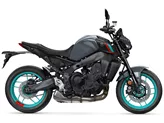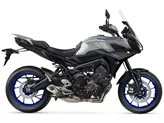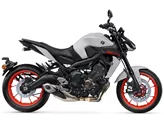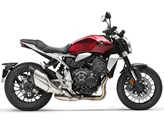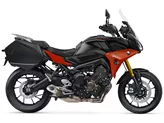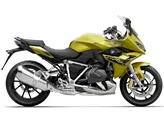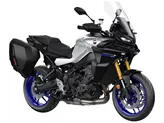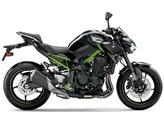Kawasaki Z 800 2013 vs. Yamaha MT-09 2016

Kawasaki Z 800 2013

Yamaha MT-09 2016
Visão geral - Kawasaki Z 800 2013 vs Yamaha MT-09 2016
The Kawasaki Z 800 2013 and the Yamaha MT-09 2016 are both naked bikes that offer a thrilling riding experience.
In terms of engine and power, the Kawasaki Z 800 2013 is equipped with an inline 4-cylinder engine that produces 113 HP of power and 83 Nm of torque. On the other hand, the Yamaha MT-09 2016 features a 3-cylinder inline engine that delivers 115 HP of power and 87.5 Nm of torque. Both bikes have a displacement of around 800-850cc, providing ample power for exhilarating rides.
When it comes to suspension, the Kawasaki Z 800 2013 is equipped with a telescopic upside-down fork at the front, while the Yamaha MT-09 2016 features a telescopic fork. Both suspension systems offer good performance and stability during rides.

Kawasaki Z 800 2013
In terms of chassis, the Kawasaki Z 800 2013 has a steel frame with a double cradle design, while the Yamaha MT-09 2016 features an aluminum frame with a double tube design. Both frames provide good rigidity and stability, contributing to a confident riding experience.
Both bikes are equipped with dual disc brakes at the front, ensuring powerful and reliable stopping power.
In terms of dimensions, both bikes have a front tire width of 120 mm and a rear tire width of 180 mm, with a 17-inch diameter for both front and rear tires. The Kawasaki Z 800 2013 has a wheelbase of 1445 mm, while the Yamaha MT-09 2016 has a slightly shorter wheelbase of 1440 mm. The seat height of the Kawasaki Z 800 2013 is 834 mm, while the Yamaha MT-09 2016 has a slightly lower seat height of 815 mm.
When it comes to weight, the Kawasaki Z 800 2013 weighs 229 kg, while the Yamaha MT-09 2016 is lighter at 188 kg. The Kawasaki Z 800 2013 has a fuel tank capacity of 17 liters, while the Yamaha MT-09 2016 has a slightly smaller fuel tank capacity of 14 liters.

Yamaha MT-09 2016
In terms of strengths, the Kawasaki Z 800 2013 offers an attractive and robust appearance, confident acceleration, relaxed geometry, and powerful brakes. On the other hand, the Yamaha MT-09 2016 boasts a wonderfully powerful three-cylinder engine, three power modes, a fully adjustable chassis, a quick-shifting gearbox, a sporty and upright seating position, good brakes, aggressive styling, and traction control.
As for weaknesses, the Kawasaki Z 800 2013 has limited legroom, which may restrict movement for some riders. On the other hand, the Yamaha MT-09 2016 has a slightly hard seat for long rides and the license plate holder on the swingarm offers less splash protection compared to a conventional holder.
Overall, both the Kawasaki Z 800 2013 and the Yamaha MT-09 2016 are impressive naked bikes with their own set of strengths and weaknesses. Riders can choose based on their preferences for power, handling, and comfort.
Especificações técnicas Kawasaki Z 800 2013 em comparação com Yamaha MT-09 2016
Prós e contras em comparação
Prós e contras em comparação
Kawasaki Z 800 2013

No geral, a Z800 teve um desempenho sensacional. Considerando o facto de que nada foi alterado ou optimizado no veículo para além do silenciador traseiro Remus, o resultado final foi excelente.
Yamaha MT-09 2016

A Yamaha MT-09 não precisava de ser reinventada para a próxima época - já estava extremamente bem feita há quase quatro anos. Em vez disso, os japoneses concentram-se na afinação e na adição de truques práticos e contemporâneos, como o controlo de tração e as mudanças automáticas. No entanto, devido à norma Euro4, a gestão do motor foi alterada mais uma vez e oferece uma potência enfaticamente potente, mas bem controlada no modo standard; a explosão de potência da primeira geração já não é oferecida nem mesmo pelo modo A mais nítido. A maior mudança, reconhecível à primeira vista, é o design, na minha opinião, extremamente bem-sucedido, com a frente mais agressiva e a traseira com novo design. Em suma, uma moto naked ainda mais elegante que foi claramente construída para a diversão do motociclismo.
Comparação de preços Preço médio de mercado Kawasaki Z 800 vs Yamaha MT-09
There are a few key differences between a Kawasaki Z 800 2013 and a Yamaha MT-09 2016. In terms of price, the actual average price of a Yamaha MT-09 2016 is about 15% higher. Compared to Yamaha MT-09 2016 there are less Kawasaki Z 800 2013 bikes available on the 1000PS.de Marketplace, specifically 7 compared to 11. It takes less time to sell a Kawasaki Z 800 with 56 days compared to 87 days for a Yamaha MT-09. Since model year 2013 1000PS.de editors have written 11 reviews for the Kawasaki Z 800 and 57 reviews for the Yamaha MT-09 since model year 2013. The first review for the Kawasaki Z 800 was published on 06/09/2012 and now has more than 8 100 views. This compares to more than 39 900 views for the first review on Yamaha MT-09 published on 10/06/2013.



